Hello, all friends. This is our new WordPress blog. We are having lot’s of fun.
We are inviting you to visit Lithuania on big festival – call Užgavėnės. Don’t forget the pancakes 😉
Užgavėnės is a Lithuanian festival that takes place during the seventh week before Easter ( Ash Wednesday). Its name in English means “the time before Lent”. The celebration corresponds to Roman Catholic holiday traditions in other parts of the world, such as Mardi Gras, Shrove Tuesday, and Carnaval.
Užgavėnės begins on the night before Ash Wednesday, when an effigy of winter (usually named Morė) is burnt. A major element of the holiday, meant to symbolize the defeat of winter in the Northern Hemisphere, is a staged battle between Lašininis (“porker”), personifying winter, and Kanapinis (“hempen man”), who personifies spring. Devils, witches, goats, the grim reaper, gypsies, and other joyful and frightening characters appear in costume during the celebrations. The participants and masqueraders dance and eat the traditional dish of the holiday – pancakes with a variety of toppings, since round pancakes are a symbol of the returning sun. In the capitol city of Vilnius, the celebration takes place on Gediminas Avenue, as well as at many youth organizations. The festival is a major event at Rumšiškės park.
Educative lecon about Užgavėnės in The National Museum of Lithuania
We are playing with mask from wood
The meat eating season started on Christmas and ended on Shrove Tuesday. In many countries this holiday is celebrated like carnival. Lithuanians preserved very old rituals and games what helped to meet spirits of dead and godnesses of nature. Everybody likes to eat a lot pancakes, hodge- podge, to soot with fire- brand, with ashes.
In the old tradition Carnival was celebrated for 8 days (starting on Sunday). It ends on the 46th day before Easter. On this day nobody is allowed to work. Modern Carnival rituals are only a small piece of the ancient traditions that were created to ensure a good harvest, and to speed the coming of Spring.
10 interesting facts:
In England pancakes were described in writing for the first time in 1439. One Dark Ages book explained that when baking it is necessary to turn the pancake over by flipping it into the air with the frying pan.
From a 1445 manuscript in England the last Tuesday before Lent was known as a day for confessing sins. On this day there were races where big crowds of people competed in running while flipping already cooked pancakes with their frying pans.
It seems for some people it was joyful. For instance Mike Cuzzacrea performed this activity for 3 hours 2 minutes 27 seconds.
Ralf Laue from Leipcigo in the last competition of the “championship of pancakes” reached the title of champion when during 2 minutes threw into the air pancake 416 times.
Throwing pancakes into the air is very old Baltic ritual meaning sacrifice for the Sun inviting her to come back sooner, to warm up the Earth and take away winter. In Lithuania it was a common custom to decorate a tree with pancakes and later with scones. There was a folk tale about an old man who hung scones on a tree.
The French call this day Mardi Gras (“Fat Tuesday”) and not only repent their sins on that day but eat plenty of meat and different fatty foods.
During “fat Tuesday” in many countries there are carnivals and various fests. The most famous of them are New Orleans and Rio de Janerio.
The French believed if while throwing the pancake you make a wish and in one hand you hold the frying pan and in the other a penny, this wish will come true.
The bigest pancake ever was made in September of 2004 Mančesterio Ročdeile. Its diameter was 15 meters, was 2.5 cm thick, and weighted 3 tons (300 kg).
Russians in March of 2002 in Moscow made the narrowest and longest pancake which was 1 km long and 150 square meters .
Next year we are inviting you to visite our festival.
All the best, Jūratė and students
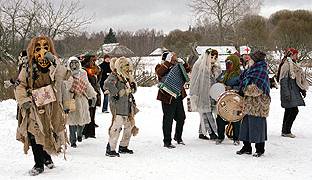
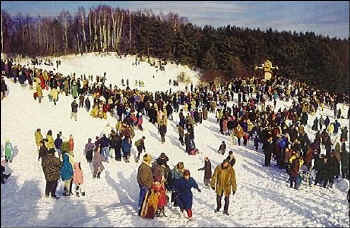
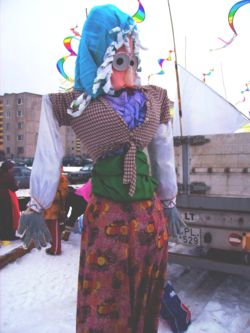
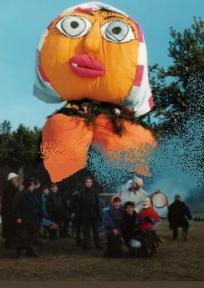

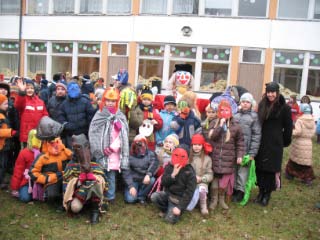








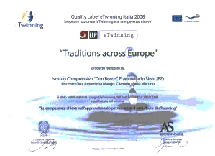


Interesting news about your festival, it ‘s got many common points with our Italian Carnival: the origins and the reasons of these festvities are the same.
Thamks for your invitation for next year!
I think we all would love to!
Good work!
Gina
Wonderful photos, Jurate, and interesting things about this celebration that we don’t have here in Romania.
My pupils and I would love to go to Lithuania on such an occasion. 😉
Thank you, partners,
I will try next week create a blog about lithuanian Kaziukas fair.
Laimingai
Does “laimingai” mean “bye” in Lithuanian?
All the best
Liliana
Let’s get lithuanian lesson 😉
Labas – hello, laimingai – all the best, draugai – the friends, projektas – project, partneriai – partners, mokiniai – students or pupils, čiau – ciao, tradicijos – the tradicions, mokykla – a school, mokytoja – a teacher, ate – bye…
So, now you can come visit us;)
Ha, ha! It’s always nice to learn something new. I must confess I didn’t know a single word in Lithuanian, but now I know. 😉
Thanks a lot!
[…] Lithuanian festival – Užgavėnės March 2008 6 comments Possibly related posts: (automatically generated)#1 Page and Top 3 Posts In 2009Reboot11,000!!! Leave a Comment LikeBe the first to like this post. […]
[…] you wa nt to know more about Užgavėnės celebrations in Lithuania, check out this 2008 blog post from Traditions Across Europe – An Entwinning. Share this:TwitterFacebookLike this:LikeBe […]